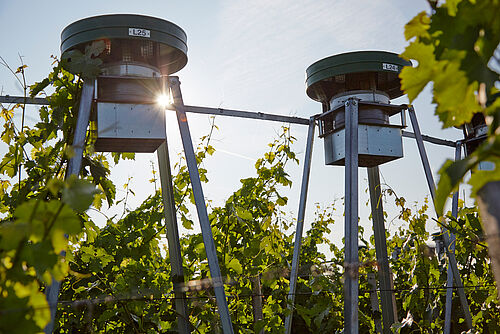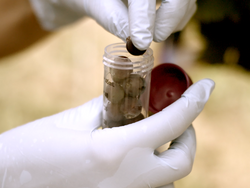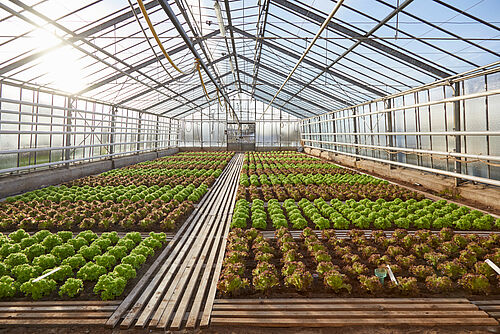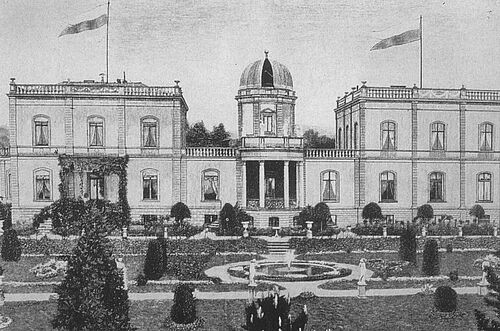Geisenheim's Research and Teaching Infrastructure
Our FACE Experiments: Insights into our Atmospheric Future
Since 2014 our scientists have been studying the effects of increased atmospheric carbon dioxide concentration on grapevines and vegetables in a one-of-a-kind research infrastructure: our FACE Facilities (Free Air Carbon Dioxide Enrichment). The CO2 concentration within the facilities is increased by about 20 % (to simulate predicted carbon dioxide levels for 2050), allowing us a glimpse into a future with elevated CO2 concentration. Under real-life field conditions with elevated CO2 levels, our scientists are studying soil processes and greenhouse gas flows to examine the effects on phenology, yield physiology, interactions between plants and pests as well as changes in substances and product quality of grapevines and vegetables.
The Vineyard FACE Facility consists of six circles with a diameter of 12 meters each (three circles are enriched with CO2 while the other three serve as control circles with current carbon dioxide levels). The circles are planted with Riesling and Cabernet Sauvignon (32 plants per circle and variety).
Our Vegetable FACE Facility also consists of six circles measuring 12 meters in diameter each. In four different segments, we are cultivating vegetables in a rotation system to conduct research on the organs of the root (radish), the leaves (spinach) and the fruit (cucumber). In addition to increasing CO2 levels, we can also vary the water supply in the four segments of each circle.
For further information, please click here.
Contact:
Prof. Dr. Claudia Kammann
Prof. Dr. Manfred Stoll
Prof. Dr. Jana Zinkernagel

Agrivoltaics in the vineyard
Can solar panels help winegrowers to mitigate the effects of climate change? Or do they even have the potential to make viticulture more sustainable? Hochschule Geisenheim University addresses these questions in the “VitiVoltaic“ project.
In a unique research project at Hochschule Geisenheim University, solar panels are installed above a vineyard to generate electricity while grapes are grown underneath. This dual use of land is called agrivoltaics, or VitiVoltaics in viticulture (the name comes from the Latin term Vitis vinifera: common grape vine). In addition to improving land use efficiency and promoting renewable energy, a PV system can help winegrowers adapt to climate change as the industry is already suffering from adverse effects such as accelerated ripening processes, drought stress, reduced acidity levels or sunburn to name only a few. Climate change is real, and the risk of late frosts, heat waves, droughts and heavy rainfall is increasing. Solar panels that shade the grapes could help mitigate the negative effects by lowering the temperature underneath the panels, improving the water balance of the grapes and reducing the damage caused by heavy rainfall. In addition, the electricity generated could be used for frost protection or vineyard management. As an additional benefit, solar panels could reduce the level of humidity of the canopies underneath, making them less susceptible to pests and helping to reduce the use of pesticides.
But how exactly do solar panels affect the grape vines, the microclimate in the vineyard and, as a result, the yield and the quality of the grapes? Do they have the potential to reduce the use of pesticides? And how can we use the electricity generated to make viticulture more sustainable? These are just some of the questions we are exploring in our “VitiVoltaic” project.
More information is available here
Contact:
Our university manages 36 hectares of vineyards for academic, research, grapevine breeding and demonstration purposes. 59 percent of our vineyards are planted with Riesling – the classic Rheingau grape – followed by other varieties that are typical for Germany such as Pinot Noir or Müller-Thurgau. This grape variety was named after Prof. Dr. Dr. h.c. Hermann Müller from the Swiss canton Thurgau, who gained worldwide attention as a scientist and also worked in Geisenheim for many years as a botanist, biologist, plant pathologist, grape breeder and teacher. In addition, we also cultivate rather unusual varieties such as the Swiss red wine grapes Gamaret and Garanoir, and the fungus-resistant white wine varieties Muscaris and Calardis Blanc. 1.1 hectares of our vineyards are already planted with fungus-resistant grapes – also known as Piwis – and the number is growing steadily.
As part of our research projects we are studying sustainable management systems as well as innovative cultivation and training systems. Our vineyards are managed in an integrated, organic and biodynamic manner. Intelligent sensor systems with modeling features serve as an important tool for making informed decisions on management-related questions. By modeling virtual Riesling grapes, for instance, we are developing new strategies and concepts for the future management of vineyards.
We focus on ecologically and economically sustainable management systems and aim to optimize all processes along the value chain. Combining latest technologies such as autonomous driving, sensor technology and digital land management enables us to identify new ways of managing vineyards.

Does grapevine age affect the quality of wine?
In a one-of-a-kind research vineyard we are studying Riesling grapes of the same clone and with the same rootstock, which were planted in a standardized booth at different times. As the vineyard was planted in 1971, 1995 and 2012 respectively, we can analyze how grapevine age affects the quality of wine made thereof. As part of the project, we focus on physiological aspects of the grapevines including yield development, tolerance to water stress and susceptibility to wood diseases. Our research vineyard also allows us to compare chemical compositions and sensory characteristics of wine and must.
Contact:
Our unique long-term study, initiated in 2006, compares integrated, organic and biodynamic management systems in viticulture.
In order to contrast the three management systems, we have cultivated the same grape variety under identical site conditions to examine the effects on growth and yield as well as grape, must and wine quality. The study also seeks to identify how management systems affect soil quality and biodiversity.
Study findings suggests that organic and biodynamic management systems lead to reduced grape yield and growth rates. The chosen system also affects the phenolic structure of the grapes as well as physical and chemical soil parameters. Furthermore, the study shows that organic and biodynamic management systems significantly foster biodiversity.
Contact:
In addition to breeding new grape varieties and rootstocks, the Department of Grapevine Breeding houses a biodiversity collection of cultivars and clones from around the world. Clonal selection aims at safeguarding the health and performance of plant material and helps to discover and develop new types with superior traits. As part of our research, we are cross-breeding rootstocks in order to achieve complete resistance to grape phylloxera in leaves and roots combined with horticultural characteristics such as good graft compatibility, superior site adaptation and a positive impact on the grapes of the scion variety.
This approach is also used to evaluate fungus-resistant varieties – so-called PiWis. In order to scientifically assess different vine varieties and their clones up to the vinification process, we vinify them separately in the experimental cellar of our Department of Grapevine Breeding.
The vinification method in small containers under standardized conditions, called microvinification, allows us to bring out the diverse taste and sensory characteristics of the individual varieties and clones. This approach is crucial, especially when vinifying different clones of a single variety, in order to best identify the wines’ typical characteristics.
Contact:
The campus winery, which dates back to the beginning of the former research institute, links the three departments of Grapevine Breeding, General and Organic Viticulture, and Enology, and enables us to translate basic and application-oriented research into practical solutions. The winery covers the entire value chain from grapevine breeding to grape production, and from winemaking to marketing. Improving and safeguarding the quality of wine is the cornerstone of our research activities. Since 1996, we have been a member of the Verband Deutscher Prädikatsweingüter (VDP) – the Association of German Prädikat Wine Estates – that proves the high quality of our wines.
Our winery covers approximately 24.5 hectares of vineyards, including outstanding sites in the sub-districts of Geisenheim, Rüdesheim and – given our research focus on steep slope viticulture – the sub-district of Kaub. As the Rheingau area is mostly dominated by Riesling, our vine varieties might come as a surprise: although Riesling and Pinot Noir are still taking center stage, they have become increasingly flanked by other national and international vine varieties.
Other departments, such as Bioscience, Beverage Science and Food Safety also benefit from the infrastructure of our winery. Grapes, must and wines that are not used for research and teaching are matured and sold to customers. Various trial wines from our new product line “Wissensdurst” (“Thirst for Knowledge”) are also on offer.
Contact
Our Department of Pomology manages approximately 13.6 hectares of land for experimental purposes. Cultivated crops include all species typical for German fruit growing, such as apple, pear, plum, sweet and sour cherry as well as quince and walnut. Apples and pears are also cultivated organically. In case of berry fruits, we focus on strawberries, raspberries, gooseberries as well as red and black currants. We use our cultivation area for breeding and breeding research, and for experiments on water supply, quality enhancement and the development of sustainable cultivation systems.
The Department of Vegetable Crops conducts research on approximately two hectares of land. With two computer-controlled irrigation carts, more than 200 parcels can be irrigated separately. GPS-controlled planting and seeding technology supports the set-up of exact field experiments to assess the impact of climate change on vegetable production, product quality and plant water relations. Based on field experiments, we develop digital tools for producers to support their decision-making processes.
In our greenhouses with a total area of almost one hectare we carry out experiments with fruit, vegetables and ornamentals throughout the year. Individually-controlled greenhouse units provide perfect conditions for studying the interaction between plants and pests. Starting in 2021, we will modernize our greenhouse facilities in terms of energy efficiency with a modern, highly transparent glass shell, which will cover our greenhouses (Venlo block construction). The heat supply will be supported by a pyrolysis plant that burns biomass produced at our university, thus creating a modern and low CO2 greenhouse area.
Contact:
How do technological processing steps influence the quality of our food and beverages and how do plant-based food products affect our health?
Our state-of-the-art laboratory network provides answers to these questions by taking analytical fingerprints from plant-based foods and beverages. Verifying product safety and authenticity as well as the best possible preservation of value-defining substances is in the center of our attention. To that end, we are also closely cooperating with industry partners and nutritionists.
Analytical procedures like wet chemical or enzymatic methods play a key role in determining main substances. As part of our research projects, we also use various liquid, gas or ion chromatographic procedures as well as molecular spectroscopic methods such as infrared spectroscopy.
In order to explore opportunities and limits of new analytical procedures, we use quantitative H-NMR spectroscopy (Nuclear Magnetic Resonance) to prove the authenticity of a product. Within just 15 minutes, for instance, we are able to distinguish direct juice from juice made of concentrate and thus identify possible counterfeits. Additionally, we seek to address some ultra-complex analytical issues that have often remained unresolved to date, such as determining the geographic origin of a food product by using a high-resolution ion mobility mass spectrometer (timsTOF) that was only procured in June 2020. The mass spectrometer, funded by the German research funding organization DFG, also provides valuable insights into the molecular composition of a food product in unprecedented depth. In current research projects, for instance, we aim to identify the molecular causes of a diet rich in fruit and vegetables, which is undeniably associated with health benefits. To that end, we are closely cooperating with agricultural researchers and nutritionists in order to track the metabolic fate of plant-based substances in food products and beverages. In view of the guiding principle "from crops to clinic", our aim is to trace health-promoting effects back to the responsible plant compounds.
Contact:
Although they are just a few micrometers in size, yeast cells play a key role for the food and beverage industry, e.g. in wine, beer and bread production. To turn grapes into wine, yeast helps to convert the sugar in grapes into alcohol during the fermentation process. The quality of the product also depends on the choice of yeast cells. Yeasts are naturally present on the grapes, however there are some yeast strains that have a negative effect on the winemaking process because they may lead to undesired aromas and flavors. To avoid these undesired results, enologists use so-called pure yeast cultures, i.e. cultivated and selected yeasts rather than a variety of different species and strains, as is the case with naturally occurring yeasts.
125 years of yeast breeding in Geisenheim.
As Germany’s first facility to produce pure yeast cultures for wine fermentation, the Yeast Breeding Center was founded in 1894 and directed by Dr. Julius Wortmann based on the studies of Louis Pasteur and Prof. Emil Christian Hansen and supported by the “Deutscher Weinbauverein” (German Winegrowers’ Association). In the years to come, institutes around the world followed the lead. Today, the Geisenheim Yeast Breeding Center is part of our Department of Microbiology and Biochemistry. Over the last decades, the center has collected a large number of pure yeast strains and has tested them for their fermentation properties and practical use. Additionally, the center has also tested fermentation processes for potential off-flavors and their causes. In the future, we aim to step up our work to include new research areas covering non-conventional yeasts.
The Geisenheim Yeast Finder provides an overview of pure yeast strains that are currently available on the market. Based on information about must and grapes, the free-of-charge online tool (www.geisenheimer-hefefinder.de) selects suitable starter cultures for individual fermentation purposes. Upon answering 17 questions on grapes, must and chosen wine style, the program compares the input with the properties of the listed yeast strains. Information about yeast properties, e.g. fermentation at low temperature, nutrient requirements and possible fermentation bouquets, comes from the yeast producers. After running a comparison, the online tool lists suitable yeast strains and indicates the percentage of the match. In addition, the tool provides the commercial name of the product, the producer and the website for further reference. We have seen increased access to our portal especially in years with low yields and/or increased grape rot or even drought stress.
Contact:
The Department of Grapevine Breeding manages Germany’s second largest collection of genetic resources of grapevines.
For rootstock breeding, we use different wild forms of the vine. Our collection covers more than 20 different Vitis species, including more than 2,000 individual forms of Vitis berlandieri alone. Based on our collections, our aim is to breed new rootstocks that show complete resistance to grape phylloxera, high tolerance to lime-rich soil, good site adaptation and high scion affinity. Safeguarding the best possible diversity within our traditional grape varieties is key to the future of grapevine breeding. Geisenheim houses a major Pinot collection and the world largest collection of Riesling cultivars with more than 1,000 accessions, which serve as a genetic pool for selecting future clones.
Contact:
In our two sensory laboratories in the Department of Enology we evaluate sensory characteristics of food products with our human senses. The laboratories are equipped with 54 test stations to teach and apply analytical sensory testing procedures, product development and quality control. By using colored light or by completely darkening the room we are able to evaluate products irrespective of their visual impression. Wine, sparkling wine and plant-based foods are particularly evaluated in sensory aspects in order to identify, for example, how changes in the production or different storage conditions affect their sensory perception. Our findings are linked with marketing and production results and analytical data. As part of consumer research projects, our sensory laboratories help to assess acceptance and preferences in terms of food choices.
Our Sensory Panel includes experienced staff members from different university departments. It evaluates test samples from scientific research projects or external customers and explores new sensory methods and their applicability.
Contact:
Sensory Laboratory: Prof. Dr. Rainer Jung
Sensory Panel: Doris Häge, M.Sc.
Our beverage technology research covers the entire value chain and product range – from fruit and vegetable-based beverages and soft drinks to coffee and plant-based milk substitutes up to beer, wine and liquors. Thanks to its technical equipment and flexible function, the current Beverage Technology Center (GTZ) and the planned new building with almost 4,000 m² in particular provide unique opportunities to combine research and teaching with a practical focus.
The current GTZ houses state-of-the-art brewery and distillery facilities and various technologies to produce non-alcoholic drinks, e.g. fruit and vegetable juices, and to process plant-based raw materials in general. The planned new building will also include a production facility for sparkling wine. Our three breweries serve different purposes: a conventional brewery with an 80 l scale is available for our teaching activities. For research activities in line with GLP standards, we use a semi-automatic facility on a 20 l scale. A brewery on a 150 l scale, equipped with a dynamic filtration system (Nessie and Vaculiq), is available for examining new processes for solid-liquid separation as an alternative to the lauter tun.
The GTZ also houses two roasters – drum roaster and fluidized bed roaster – for roasting coffee, cocoa, nuts and oilseeds. By closely combining technology-related activities of the GTZ with the analytical expertise provided by the Department of Beverage Research, we are setting new standards in the respective degree programs and in beverage research.
Contact:
- Head of Department of Beverage Research: Prof. Dr. Ralf Schweiggert
- Operations Manager GTZ: Dipl.-Ing. (FH) Michael Ludwig
- Brewery and Coffee Technology: Prof. Dr.-Ing. Bernd Lindemann
- Questions regarding cocoa, chocolate, allergen management as well as microbiological and instrumental analysis: Prof. Dr. Simone Loos-Theisen
A high-tech meteorological network consisting of 13 weather stations located in the Rheingau and Hessische Bergstrasse regions forms the basis for forecasts, which we supply to over 350 winegrowers as a "weather fax" – now also online – to help them make informed wine-growing decisions.
In addition to air temperature, relative humidity, precipitation, wind speed and global radiation, each station also measures the temperature 70 cm above ground, which roughly corresponds to the point at which the vine bends. These data are used, among other things, to forecast infestation with the pathogen that causes downy mildew (peronospora), vine development and to calculate leaf area per shoot. The readings also help us to better understand the effects of climate change and its implications for viticulture.
Contact:
Meteorological Network: Dipl.-Ing. (FH) Ottmar Baus
Two historical parks serve as the “lungs” of our university, while also actively symbolizing the link between research and teaching. Extending over a total of five hectares, the area is divided into the university park around the Administration Building and Monrepos Park, which surrounds the neo-classical Villa Monrepos. Heinrich Eduard von Lade, the founder of the Königlich Preussische Lehranstalt für Obst- und Weinbau zu Geisenheim, had a broad range of interests and built the latter as his retirement home between 1860 and 1863. Simultaneously, the park was laid out based on the model of an English landscape garden and – following in the tradition of a demonstration and educational garden – underwent significant changes during the terms of office of the various Institute directors. Today, its design features are considered a rare example of the formal gardening language typical of the 1950s and 1960s. Further highlights of the Monrepos Park include its large open spaces featuring an impressive sequoia, Lebanon cedar and oriental arborvitae.
The extensive collection of trees and shrubs in the university park still includes several specimens from the period in which it was originally laid out - a collection of non-native plants that reflects the spirit of the era. Exotic species and rarities, such as the Osage orange (maclura pomifera), the edible persimmon or the cut-leaf walnut delight plant enthusiasts. Another impressive variety is the black walnut, which is one of the largest specimens in Germany with a trunk circumference of over 4.80 meters. The “Iris Garden” is home to a digital beehive, which is part of a worldwide network of high-tech beehives researching how environmental factors impact bees. These inviting surroundings also provide the stage for our graduation ceremony every summer.
Contact:
University Grounds: Prof. Dr. Alexander von Birgelen
As part of the Geisenheim business analysis, our Department of Wine and Beverage Business has been assessing the economic success of German wine estates for over 30 years now. Within the framework of our analysis, participating wineries get an overview of their current economic situation and improvement potential. Due to structural changes in the wine industry, economic performance has become a crucial factor over the last years – only economically successful wineries will have a future and find a successor.
Therefore, we have fundamentally revised the project and developed a new graphic evaluation of the winery’s economic performance over the last five years. Our aim was to make the evaluation more comprehensible so that winegrowers can better implement the results in their day-to-day business. So far, more than 700 wine estates have benefited from our analysis. The project is funded by the Federal State of Rhineland-Palatinate, the Hessian Ministry of Higher Education, Research, Science and the Arts and the European Union.
Contact:
Prof. Dr. Simone Loose
Hochschule Geisenheim University maintains a study and research garden on the university grounds since 2020.
The garden provides the perfect framework for designing, building and managing construction projects that are typical for our industry, e.g. paths, terraces, walls and staircases. In collaboration with students and the interested public, we are also creating special constructions, for instance fully automated irrigation systems, natural self-cleaning swimming ponds, light and sound installations as well as possibilities for the autonomous maintenance of vegetation areas. Our research garden is much more than just a simple showground – from the very first day, we collect ecological data (material and energy consumption) of buildings and construction materials to assess them in ecological terms and carry out life cycle assessments, which are the basis for building information modeling (BIM) and sustainable construction.
Tailored sensor and measurement technology records adverse effects of climate change such as heavy rainfalls and water shortages in plants. In collaboration with industry partners, we are investigating the scope of these effects to identify structural solutions. For example, we are working on a tailored and site-specific irrigation process including an intelligent control system as well as decentralized infiltration units and open-pore path and square pavements.
The key focus of our study and research garden is to provide answers to future questions and challenges posed by climate change. The showground for construction technology in landscape gardening is open for students, the interested public, landscape architects as well as garden and landscape designers.
Contact:
Prof. Dr. Andreas Thon
The citizen science project “we4bee” seeks to illustrate the behavior and needs of honeybees. As part of the project, 100 fully electronic beehives were distributed – one of which has also been located at our university since the beginning of 2020. This special beehive called TopBarHive is equipped with a temperature sensor on the inside of the hive and a sensor for wind, light intensity and precipitation on the outside. Every 15 minutes the sensors transmit data to the project network by using a LAN connection. In addition to high-tech sensors, cameras have been installed on the inside of the beehive and opposite its entrance to collect data on living and environmental conditions of bee colonies. The “we4bee” app allows users to retrieve data and to view recordings. As part of the project, the University of Würzburg evaluates the collected data by means of big data analytics and machine learning methods and provides the results to the general public. In addition to the “we4bee” project, our interdisciplinary master’s module “The Bee” gives students more detailed insights into beekeeping, the beehive and its environmental parameters, thus creating connections to our various master’s programs. Students learn strategies for preserving and enhancing biodiversity in different cultivated landscapes, which is exactly the focus of “we4bee”.
For more information on the Geisenheim beehive, please go to www.we4bee.org
Contact:
Dr. Susanne Tittmann

